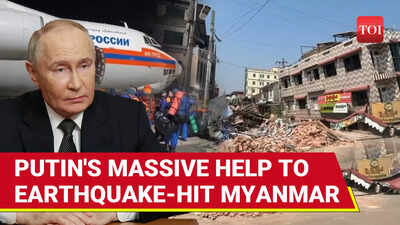Trending
Myanmar earthquake aftermath: Satellite images show collapsed infrastructure and huge-scale destruction
A recent 5.1 magnitude earthquake in Myanmar exacerbates devastation from a prior 7.7 magnitude tremor, leading to over 1,600 fatalities, nearly 3,400 missing persons, and massive displacement. Critical infrastructure damage hampers aid delivery, with India and China providing essential relief supplies.
Myanmar is located in a seismically active region, which makes it a highly vulnerable area to earthquakes. The country lies along the boundary between the Indian and Eurasian tectonic plates and experiences frequent seismic tremors due to the persistent collision and movement of these plates. This tectonic positioning makes Myanmar particularly prone to earthquakes, some of which can be devastating. Over the years, the country has faced numerous tremors and earthquakes, with varying degrees of destruction but the recent one has wreaked havoc across the country and its neighbours.
On Sunday, Myanmar was struck by another powerful 5.1 magnitude earthquake, just days after a 7.7 magnitude tremor devastated the country on Friday. The initial earthquake has already claimed more than 1,600 lives, leftover 3,400 missing, and displaced over a million people. Despite continued rescue operations, many residents, especially in Mandalay, have been forced to spend the night outdoors, having lost their homes in the initial earthquake.
Critical infrastructure has been severely impacted, including airports, highways, and bridges, hindering the delivery of much-needed humanitarian aid.

Newly released satellite images show huge scale destruction
Satellite images from Myanmar have shown the scale of the devastation, including collapsed buildings and infrastructure among which an image shows the collapsed control tower at Nay Pyi Taw International Airport, that was taken just a few days after the earthquake.
The UN Office for the Coordination of Humanitarian Affairs has brought to light the dire shortage of medical supplies that is hindering relief operations. A spokesperson for the UN said that essential supplies, including trauma kits, blood bags, and anesthetics, are urgently needed.

"Hospitals are really struggling to cope with the influx of injured people, there's a shortage of medical supplies, and people are struggling to find food and clean water," she told the Associated Press. Local volunteers have been stepping in to fill the gap where government aid is scarce.

India sends aid through 'Operation Brahma'
India, through "Operation Brahma," has sent two C-17 military aircraft carrying supplies to set up a field hospital in Nay Pyi Taw.
This emergency treatment center has a capacity of 60 beds and will provide crucial care to those who were injured in the earthquake.

China has also sent over 135 rescue workers, medical kits, and generators to support the relief effort. Their state media has also reported that 12 people had been injured due to the aftershocks.
End of Article
FOLLOW US ON SOCIAL MEDIA
Visual Stories
Tired of too many ads?










